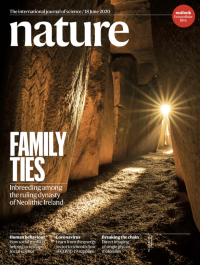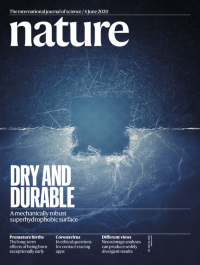Volume 582
-
No. 7813 25 June 2020
Gain of functionParkinson’s disease is characterized by the loss of neurons that produce the neurotransmitter dopamine. A cure for the condition remains elusive, and current treatments focus on relieving the symptoms. In this week’s issue, Xiang-Dong Fu and his co-workers report a way to generate new neurons to replace those lost to the disease. By depleting the levels of an RNA-binding protein called PTB, the researchers have established a single-step method that can efficiently convert astrocytes into functional neurons in live mice. The new neurons reversed the loss of dopamine and restored some motor function in a mouse model of the disease. The technique also works with human cells in vitro, suggesting that it offers a possible route to treatments for neurodegenerative conditions such as Parkinson’s.
Spotlight
-
No. 7812 18 June 2020
Family tiesThe cover shows sunlight piercing Newgrange passage tomb in County Meath, Ireland, following the winter solstice. In this week’s issue, Daniel Bradley and his co-workers present a genomic exploration of remains from this and other megalithic sites that sheds fresh light on social organization in the country more than 5,000 years ago. Sampling the whole genomes of 44 individuals, the researchers discovered that the high-status remains of an adult male in the Newgrange tomb represented the offspring of an incestuous liaison between either a parent and child or a brother and sister. They also found distant relatives of this man at two other major sites. Broader dietary and genetic differences were seen between passage-tomb burials and the other genomes sampled, indicating that they were probably part of ruling class, whose leaders engaged in dynastic incest to keep themselves distinct from the rest of the population.
Nature Outlook
-
No. 7811 11 June 2020
Defying gravityCooling and trapping atomic gases to form a Bose–Einstein condensate (BEC) allows quantum behaviour to be examined at a macroscopic scale. But it is hard to exert precise control over these exotic states of matter when gravity interferes. In this week’s issue, Robert Thompson, David Aveline and their colleagues take a marked step away from gravity’s constraints and present details of the first BEC to be created in orbit. The researchers made use of the Cold Atom Laboratory, which was installed in the International Space Station in June 2018. Freed from the pull of gravity, the freely evolving BEC was sufficiently stable to allow for longer observation and could be held in types of traps that cannot be used on Earth. The ability to generate and maintain BECs on the space station should offer the potential to perform high-precision measurements of fundamental quantum effects.
-
No. 7810 4 June 2020
Dry and durableSuperhydrophobic surfaces have a range of applications in biotechnology and medicine thanks to their ability to stay dry, keep clean and avoid biofouling. Their water-repellent properties come from nanoscale surface roughness, which minimizes contact between the liquid and the surface. But this comes at a price, as it also makes the surface fragile, leading many to believe that high water repellency and material robustness are mutually exclusive properties. In this week’s issue, Robin Ras, Xu Deng and co-workers suggest otherwise. They present a surface constructed at two length scales: a nanostructure that imparts high water repellency and a microstructure frame that houses pockets of the nanostructure. The researchers describe the frame as an armour that protects the nanostructure and say the concept can be applied to silicon, ceramic, metal and transparent glass to form superhydrophobic surfaces that can withstand a steel blade and sandpaper abrasion.
Focal Point




